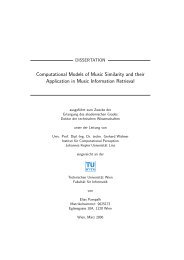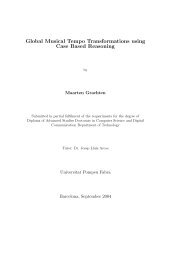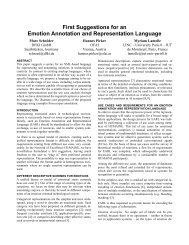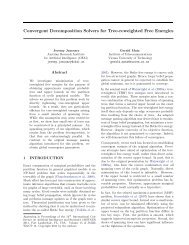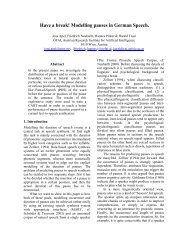A HYBRID MODEL OF REASONING BY ANALOGY
A HYBRID MODEL OF REASONING BY ANALOGY
A HYBRID MODEL OF REASONING BY ANALOGY
Create successful ePaper yourself
Turn your PDF publications into a flip-book with our unique Google optimized e-Paper software.
) concurrency in the running of several reasoning processes each possibly associated with a<br />
different task.<br />
4. A <strong>HYBRID</strong> COGNITIVE ARCHITECTURE<br />
A theory of cognitive architecture is a theory of the basic principles of operation built into the<br />
cognitive system (Anderson, 1983). The cognitive architecture is an integrative explanation of<br />
cognition that comprises a unified description of mental representation, memory structures and<br />
processing mechanisms. In the recent years several proposals for cognitive architectures have been<br />
made, for example ACT* (Anderson, 1983), The Society of Mind (Minsky, 1986), Soar (Laird,<br />
Newell & Rosenbloom, 1987, Lewis, et al., 1990, Newell, 1990, Rosenbloom et al., 1991),<br />
PUPS (Anderson, Thompson, 1989), PRODIGY (Carbonell et al., 1990).<br />
Studying human cognition I have been led by the assumption that it is not possible to build an<br />
adequate model of an isolated cognitive phenomenon. Cognitive processes are too complex and<br />
interrelated to be modeled separately, and I believe that it is necessary to have a cognitive<br />
architecture on the basis of which different models of different phenomena can be proposed.<br />
Consequently, a cognitive architecture has been put forth (Barnev & Kokinov, 1987, Kokinov,<br />
1988a), which is developed further in (Kokinov, 1989, Kokinov & Nikolov, 1989) and in the<br />
present chapter. On the basis of that architecture a model of human recalling and forgetting<br />
(Kokinov, 1989) as well as a model of human reasoning (Kokinov, 1988b, Kokinov & Nikolov,<br />
1989, and the present chapter) have been proposed.<br />
The cognitive architecture described here is a hybrid one. It combines the symbolic approach (a<br />
frame-like representation system with parallel running symbolic processes and a marker-passing<br />
mechanism) and the connectionist approach (a localist connectionist network with an associative<br />
mechanism). The symbolic aspect of the architecture performs the reasoning proper whereas the<br />
connectionist aspect makes it effective, context- dependent and dynamic.<br />
4.1. Dualistic Representation<br />
As we have seen so far at least two aspects of the world have to be represented in the reasoner's<br />
mind: 1) knowledge about the world - concepts, objects, events, plans, etc. and 2) their<br />
associative relevance with respect to the particular context. These two aspects are orthogonal.<br />
The proposed architecture reflects both aspects. Concepts, objects, situations, plans, actions, etc.<br />
are naturally represented by corresponding descriptions (frame-like symbolic structures), whereas<br />
their associative relevance is represented by the level of activation (a numeric value) of these<br />
descriptions.<br />
We can consider the frames as nodes and their slots as links between the nodes (actually a frame in<br />
our representation scheme is nothing more than a bunch of highly structured and named links). In<br />
this way the long term memory (LTM) is considered as a network of nodes and links (where<br />
nodes correspond to concepts, objects, events, actions, situations, etc., and links to semantic<br />
relations and arbitrary associations). Ascribing weights to the links and activation to the nodes, and<br />
abstracting from the semantic interpretation of the links, we can think of the LTM as a large localist<br />
connectionist network.<br />
In this way each link and node in the network has a dual interpretation: one within the symbolic<br />
representation (Figure 3a) and one within the localist connectionist network (Figure 3b).<br />
>




